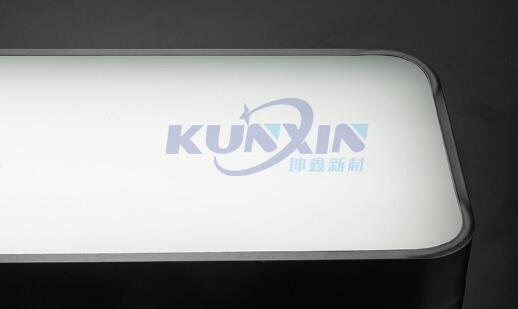-
Mob.:
+86 135 9088 4785
+86 135 9088 4785
The global light diffusion materials market can be divided into polycarbonate (PC), acrylic, polypropylene, and other sheets based on product. Acrylic and polycarbonate plastics are often recommended for various applications where the material’s size, weight, and strength must be considered. While contrasting acrylic and polycarbonate lighting lenses, it’s necessary to consider the user’s strategic objectives.
But which one is the best? Here in this article, we will dig into which is superior and why.

Acrylic diffusers produce a soft lightning effect by regulating the brightness of harsh lighting. They can also help save energy by offering more even lighting, reducing the need for additional fixtures. Besides, they protect lighting fixtures from dust as well.
Bulk polymerization is the process by which acrylic plastic polymers are formed. Batch cell or continuous system processing is used to form the acrylic, depending on the thickness and shape required.
Polycarbonate Light Diffuser is a light diffuser material that comes in thicknesses ranging from 0.5mm to 6mm. LED lights, DIY lights, office lamps, kitchen lights, and fluorescent lights all have polycarbonate light diffusers as covers.
Bisphenol A (BPA) and Phosgene are used to make it. Polycarbonate can be made in a variety of ways, including by free radical polymerization. Polycarbonate has the benefit of being a thermoplastic, which means it can be molded while still hot. It can not quickly melt or be formed after it has cooled.
Various LED manufacturers consider acrylic and polycarbonate (PC) to be suitable light diffusion materials. Because of their low absorption coefficient and design freedom, these two transparent and designable plastics are slowly replacing glass in LED applications.
Here to differentiate these two light diffusers, we will focus on the qualities of both diffusion materials.
● More affordable than glass and also polycarbonate;
● 17 times impact resistance of glass;
● In all densities, 92 percent of light passes through;
● Sunlight discoloration or yellowing is not an issue;
● Thermoplastic with a consistent operating temperature of 180°F;
● Scratches and dents won’t hurt it;
● Sheets can be buffed to a mirror-like finish;
● Easy to reduce;
● Curving warmth;
● Clean glue joints;
● Shiny surface;
● Colors come in a wide range of hues;
● Widths from 48″ to 108″;
● Various sizes are available, ranging from 72″ to 192″;
● 250 times impact resistance of glass, 30 times powerful than plexiglass sheet;
● There are a variety of bullet-resistant qualities available;
● Light passes through at a rate of 90%;
● Far less rigid and available in a wide range of adaptable grades;
● Polycarbonate sheet with a constant working temperature of 240F;
● Flammability is minimal;
● Chips and cracks are not an issue;
● Acid and other substances, such as oil, are very resistant to it;
● You can do drilling without fear of breaking the sheets;
● Cold-formed or curved without home heating;
● Widths ranging from 38″ to 75″;
● Sizes range from 78″ to 150″ in length;
A variety of materials can create light diffusers, but acrylic plastic is one of the best. Consider the following cases first:
● You need diffusers for a custom-made LED lighting rig;
● You want to replace the diffusers on your current LED lights;
For both cases, Acrylic light diffusers are the plastic material with the best light transmission capabilities. Besides, these diffusers soften the light emitted by your LED fixtures. So there is no light diffusing material that provides a cost-effective and straightforward solution like Acrylic.
Why Do We Recommend Acrylic For Your Light Diffuser?
There are numerous logical reasons why we recommend Acrylic diffusers for your light diffuser. Just dive into the following advantages:
Acrylic is less expensive than polycarbonate. Polycarbonate is typically 30-40% more costly than Acrylic, depending on the finished product and length.
Acrylic plastic diffusers are mechanically robust, and well-made acrylic diffusers can survive several years of use. They are more resistant to cracking and can withstand more physical violence than polycarbonate and glass diffusers.
All light diffusers reduce the amount of useful light emitted by an LED fixture. While using polycarbonate or frosted glass diffusers will dramatically dim your lights. Whereas Acrylic plastic has a special structure that allows it to disperse light efficiently. It also reduces usable light levels to a minimum.
Acrylic plastic is often more scratch-resistant than other diffuser materials. Moreover, it will not discolor when exposed to direct sunlight, as polycarbonate plastic diffusers often do.
Acrylic plastic is a very flexible option if you need to make light diffusers with printed designs. It is also perfect to create a unique diffuser design for a hotel lobby or corporate conference center. You can easily create exquisite and stunning custom diffuser designs that will give your commercial space some serious visual flair.
Apart from our recommendation, consider several factors when choosing a plastic material for the light-diffusing application. The type of light source, the impact potential, flammability standards, outdoor exposure, budget, and temperature range.

Copyright ©Kunxin New Material Technology Co., Ltd. All Rights Reserved | Sitemap | Technical Support: 